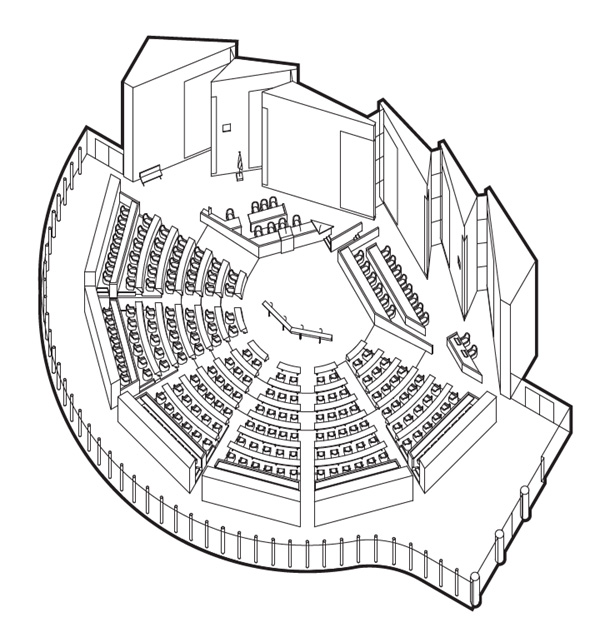Introduction
Early in 2015, both the House of Representatives and the Senate of the Netherlands started planning to move house. This was after it had become clear that the then-occupied historic buildings, partly dating from 1655, were in need of renovation. During the summer break in 2021, both Houses moved for an expected period of five to seven years to separate, new but temporary locations. The total cost of renovation, moving houses and temporary locations is an estimated 600 million euros. This operation includes an extensive overhaul of the plenary and other meeting rooms . The move has had a big practical impact on the staff, especially parliamentary reporters.
The Sub-optimal location of reporters in the plenary hall
According to common wisdom, moving house comes in third in the top three most stressful events, after the death of a spouse and a divorce. That does not bode well with the relocation of a public company like the House of Representatives, with a total of more than 1000 people working in it, comprising civil servants and support for the various political groups. As the relocation co-ordinator for the Parliamentary Reporting Office (PRO), I emphasized the continuation of business operations in my work, with the bottom-line position being that all functionalities are retained and perform properly. So a move “as is” with improvement where possible was the starting point in 2018.
However, in 2019 it became apparent that other forces were also at work, such as the call to relocate the reporters in the plenary hall. It was suggested from various quarters that the position of the reporters – in the middle of the plenary hall – was perceived as sub-optimal. This discussion was a big surprise and a source of worry among parliamentary reporters. PRO reporters had always taken centre stage, starting in 1849. Moreover, the effects of this small, extra move were unclear.
International perspective: Where do reporters sit in the plenary halls?
Luckily there was a chance for the PRO to feed into the discussion: a study was carried out on our behalf by architectural firm XML, known for the book, and accompanying website, Parliament (2016) which documents and compares plenary halls of all 193 UN member parliaments. The research focused on the position of the reporter in the plenary hall in parliaments across Europe. Denmark, Norway, Sweden, Germany, France, the United Kingdom, the European Union, Estonia and the Scottish Parliament were considered. In each of the examined halls, the reporters have a seat in the plenary hall, with the exception of Estonia, Scotland and the UK House of Commons. This has to do, for example, with the possibility for the MPs to speak from seating position; in Estonia and Scotland the parliamentarians conduct the debate from their own seat. This is not the case in the Netherlands.
In the research findings, three positions for reporters in the plenary hall emerge: 1. as part of the rostrum (that is the normally raised platform where the chairperson and leading officials sit), such as in France; 2. as an independent element in the hall, such as in the Netherlands and Germany; and 3. outside the hall, such as in Estonia. In general, preconditions for the ideal place for reporters are found in an overall good view of the verbal and non-verbal elements in the debate, including speech intelligibility. In view of the messy layout of the plenary hall in the Dutch parliament, with no fewer than four different speaking positions (Chairman, lectern, cabinet and an interruption block), a place outside the hall (3) was abandoned. In the decision-making process on this matter, the other two options were also successively abandoned; a stalemate was imminent. So the PRO, together with the architect, devised an alternative, a two-person desk on the right (see the picture below), very loosely based on the situation in the Scottish Parliament. There the reporters sit in a room next to the hall, separated from it by a glass wall.

Mitigating the effects of the small move
In the aftermath of this discussion, the PRO started preparations for working with both a new desk and a new position in the plenary hall. Part of that preparation was an early field test in the summer recess of 2019. This test had to meet two conditions: 1. to be as realistic as possible and therefore as valid as possible, and 2. to be performed by the reporters in order to obtain the necessary support from the front-line. This practical test entailed that the new desk and position were simulated as closely as possible, and subsequently tested by a representative group of the report and editorial staff of the PRO during a number of test meetings in the plenary hall. To this end, a professional mock-up was built of the new PRO desk, which at that moment only existed as an architect’s drawing.
The following evaluation “View of the debate” (September 2019) showed that there were concerns about the view of the interruption microphones and the view of the President, as well as about the audibility of statements made outside the microphone’s range. The ensuing concern about the quality of the reporting focused on hard-to-hear passages wich would therefore not be included in the report. Surprisingly, the move of both Houses, scheduled for 2020, fell through at the last minute due to political disagreements. However, just as surprisingly, it was decided to implement the change of position for the reporters in the plenary hall anyway.
In May 2020, a new chapter started in the old plenary hall, with a new position and a new desk for the PRO. The desk was no longer the previous mockup but one designed by an architect specially recruited for this purpose. A new review “View of debate 2.0” (June 2020) concluded that the reporters were mostly positive about the change. However, complaints about poor sightlines and especially audibility during busy moments in the debate, such as Business of the House, remained. Mitigation measures have been successfully sought in, among other things, adjustments to the desk such as recessed screens and improved sound amplification.
Finally, at the start of 2021, political disagreements about the move subsided: the decision to move was finally taken. In July 2021, the move to B67 started and was successfully completed in September – the first meeting in the plenary hall took place on Tuesday, 7 September. All systems were tested and in place. After a dress rehearsal in August, including testing the plenary hall in session with the new PRO desk in place, we seemed to have reached business as usual. Covid and the associated measures to limit its spread, including in the Netherlands the requirement to keep 1.5 metres apart, turned out to have a greater impact than the small PRO-relocation; that suddenly seemed less important in the minds of many professionals.
Conclusion
We have now been working for some time in our new temporary housing and in the new plenary hall, with a new positon and a redesigned desk. This big change for the PRO has been made without the general public or the media even noticing. Whether that is good or bad is for others to judge. The fact that the quality of the reports has not deteriorated is, in hindsight, mainly due to three factors: 1. the comparative study and the alternative suggestion ordered by PRO; 2. early field testing; and 3. the tireless efforts and great adaptability of the reporters. They rightly showed themselves to be “narrow-minded specialists” as they are seen by many. This is usually not intended as a compliment. That said, their involvement was key to the fact that the change was ultimately succesful.
Henk-Jan Eras is Quality Officer in the House of Representatives of the Netherlands. He is also a member of Tiro’s editorial team.
Reference
Parliament. 2016. XML: Amsterdam.




